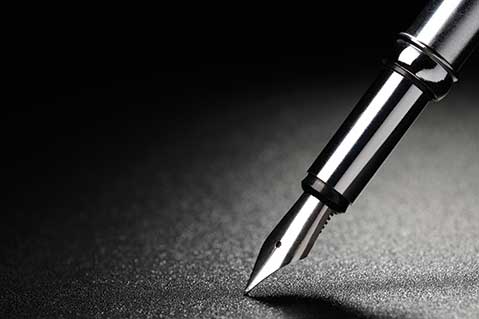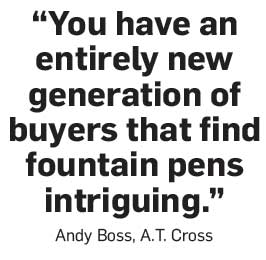September 08, 2016
Fountain Pens Making A Comeback
Far from a bygone relic, fountain pens are staging an unlikely resurgence.
Popularized well over a century ago, fountain pens were long prized for their innovation (no more dipping pens in ink!) and design – until the ease of ballpoint pens pushed them to the periphery of the writing instruments sphere.

Now, decades later, fountain pens are demonstrating surprising resiliency. Not only are sales burnishing in retail, but the promotional product industry is witnessing a similar revitalization. “It actually caught me a bit by surprise,” says Andy Boss, the North American sales manager for corporate gifts at A.T. Cross Company (asi/47520). “We have offered fountain pens in our catalog for years, and while we always had a steady stream of fountain pen fans, it seems like [the] last two years we have had an entirely new interest in that technology and from a younger audience.”
Part of the resurgence is the infatuation with vintage in pop culture, fashion and design. Vinyl record sales were up 52% in 2014 and then rose again by 30% last year, the 10th consecutive year of growth according to Nielsen. High-waisted pin-up style shorts, skirts and swimsuits are trendy again. Polaroid pictures and instant film are also making a comeback.
“I think you have an entirely new generation of buyers that find fountain pens intriguing and ‘new,’ as crazy as that sounds,” Boss says. “While most fountain pens come with an easy-to-use ink cartridge, the idea that if desired you can insert a converter and then draw your own ink out of an inkwell or bottle is just kind of cool.”
Tim Cullen, the owner of Hooligan Pens, makes custom handcrafted fountain pens and says he gets requests from people of all ages. “I don’t think there’s any one demographic,” he says. “I just made a pen for a girl who had just graduated from nursing school who is 22, 23 years old. It’s not just baby boomers, it’s also young people. “My daughter is 18 years old. She wanted a Harry Potter fountain pen for her birthday, so I made it, and she loved it.”
R.J. Hagel, marketing manager at Goldstar Pens (asi/73295), says that because retro and “steampunk” styled products have become more popular, fountain pens are a natural choice for people who appreciate that aesthetic. “Not only do they offer a nostalgic feel, but their writing experience is unlike any other writing instrument offered,” Hagel says. “Those who do enjoy writing by hand communicate a form of elegance and old world feel in their writing.”
Fountain pen enthusiasts have taken to the internet the past couple decades to connect with each other on forums, blogs and over Facebook, opening up a once-guarded sect. “People are now able to easily share their beautiful calligraphy and new pen pictures with their entire community, which also draws potential [fountain] pen users in,” explains Leena Shrestha-Menon, owner of retailer and online seller Pen Boutique in Columbia, MD. “In addition, folks who live in remote locations can look at and buy nearly any pen on the internet now, when before they would have had to drive to their closest city.”
Fountain of Knowledge
Fountain pens are certainly different than a standard ballpoint pen. Here is a breakdown of its features, as demonstrated on this chrome fountain pen with gold trim that features a brass nib and 1.5” x .25” imprint area. Available from Aeropen (asi/33075); www.aeropen.com.

1 Nib: How ink is transferred to the paper. Nibs are generally stainless steel or gold; the most common sizes for general use are “fine” and “medium.” The more you write with a fountain pen, especially one with a gold nib, the better the pen will work because the nib gets worn in. One other distinction: Calligraphy pen nibs are flat, which allows for the variation in line thickness, while regular fountain pen nibs tend to be more rounded so that the line width stays mostly uniform, regardless of writing direction.
2 Feed: How the ink travels from the inside of the pen to the nib. The row of parallel slices allow for air to enter and take the place of departing ink to prevent blotting.
3 Ink: Fountain pens use liquid water-based ink that is either stored in a cartridge or is drawn up into the body of the pen from an inkwell or bottle. This is different from ballpoint pens, which use thicker oil-based ink that requires more pressure to leave a mark. The ease of the ink lends itself to cursive, where the letters are all connected. And it requires a lighter touch when writing.
“You shouldn’t press down very hard on a fountain pen because you could spring the tines on it,” says Linda Pennington, a sales representative at the Pen Boutique.
4 Cartridge: Unlike ballpoint pens, fountain pens are refillable and use different types of systems. This pen uses a pre-filled cartridge that can be inserted when the old one runs out.
Follow the Script
Fountain pens indisputably write different than today’s popular ballpoint pens. Their thinner ink and fluid motion make them the preferred tool of calligraphy artists because there are so many ways to customize the writing experience and style (such as switching out the nibs for different thicknesses and experimenting with different color inks). “In terms of calligraphy, there is no better pen for it,” says Valérie Bélanger-Cantara, customer service manager at PenUSA (asi/76850). “Think of it as the paintbrush amongst pens.”

But just because fountain pens are suited for more artistic applications does not mean they are limited to that. “In terms of functionality, there is not a whole lot a fountain pen can’t do that a ballpoint or rolling ball can,” Boss says, “so they really can be used by just about anyone in any market.” That’s reflected in what Boss terms “a huge swing in price points.” Affordable varieties include resin-based pens with steel nibs, while precious metal pens with solid gold nibs offer high-end value.
Fountain pens aren’t an ultra-expensive corporate gift, yet they still carry that high-end perception. Bélanger-Cantara says that since fountain pens have been around for such a long time, they have become a classic item and are seen as having a certain level of sophistication. She says that in the promotional products industry, fountain pens are mostly given as gifts to employees as a “thank you” gesture.
“While they certainly can be used for any occasion,” adds Boss, “they really hit the mark as a recognition gift for a job well done, career milestone or special event.” And certainly more expensive fountain pens work as a coveted status symbol, making them great gifts for board members, high-end clientele, business partners and more, according to Hagel.
“[Fountain pens] are more professional,” says Jean Traynor, owner of Belmont Writing Instruments, a manufacturer of pens. “[People] want to look good. ... It’s a style thing, it has class.” Traynor says that a fountain pen as a promotional product is great to use in the corporate world. He also says they’re very popular among lawyers, doctors and executives. “The higher-ups want a higher-end pen,” he says.
It’s worth the extra money to buy a higher-quality pen, in Traynor’s opinion. He says one of the benefits of using a fountain pen over other types of pens is that the flow of the ink is much better and the pen glides over the paper with ease. “If you want a quality pen,” Traynor emphasizes, “you buy a fountain pen.”

Product Hub
Find the latest in quality products, must-know trends and fresh ideas for upcoming end-buyer campaigns.